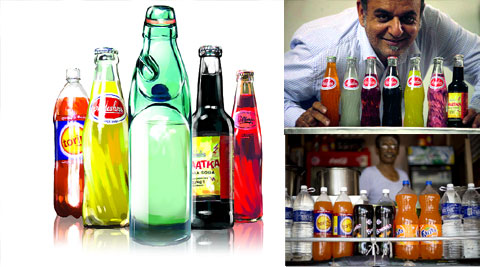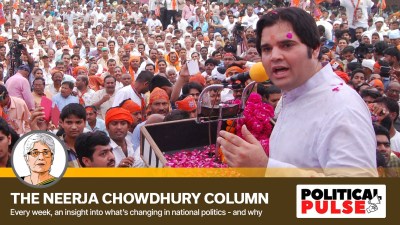- India
- International
India’s homegrown sodas that survived despite cola wars
Unlikely survivors of the cola wars, many of India’s homegrown sodas get by with astute marketing and a little help from nostalgia.
By V Shoba with Kevin Lobo, Kamal Saiyed, Shikha Sharma and Partha Sarathi Biswas
 The many sodas at Pune’s Ardheshir and Sons’; Torino and Bovonto give Fanta a run for its money at a Madurai shop.
The many sodas at Pune’s Ardheshir and Sons’; Torino and Bovonto give Fanta a run for its money at a Madurai shop.
At the height of summer in Madurai, a mysterious drink with a hint of dark fruity-ness flourishes in refrigerators. Its placebo effect in case of an upset stomach is legendary. Locals will tell you that it is the one thing you should drink after a kari dosa or other fiery eats from Madurai’s streets. So when crates of Kalimark’s Bovonto are unloaded from Sendhur Mani’s old cycle-trailer at small tea stalls flanking West Veli Street, there is a happy clamour. “Bovonto is timeless,” says S Umar of Zam Zam Tea Shop, receiving three crates of south India’s oldest homegrown soft drink. Forty-seven-year-old Mani, one of over two dozen Kalimark distributors in town, supplies to 60 shops every morning before popping open a bottle of grapey goodness for himself. “I don’t think Bovonto will ever go out of business,” he says.
For a generation of Tamils, soft drink is “colour” and colour is the neon orange pop of Torino or the caramel tint of Bovonto. “It is the taste of my childhood,” says R. Sivasailam, 39, a software engineer in Chennai. “We would add salt and lime to Bovonto and pour it on ice. Tell me which foreign soda can taste so good with Indian food.” A true-blue Indian soda pop that refused to cede the battleground to multinational colas, Bovonto is a formulation of the century-old Kali Aerated Water Works. Worth over Rs 100 crore, it continues to expand its footprint in south India.
Every year, the cola wars pit blue against red, Pepsi against Coke, 7Up against Dew as the multinationals stake out their territories across India. But, like the last outpost of Gaul defiance against the Romans, homegrown sodas survive in many parts of India — their fabled histories reminders of older times, their quirky flavours a part of many memories.
In 1977, as Coca-Cola was beating a retreat from India under the provisions of the Foreign Exchange Regulation Act, Torino, an orange soda with a prodigious use of sugar, entered the market in south India. “In no time, we had captured 90 per cent of Karnataka’s orange soda market,” says Pankaj Lakhani, the second-generation owner and MD of Bangalore Soft Drinks. Torino has since been re-launched in PET bottles across Karnataka, where it has over 60 distributors, and Tamil Nadu, where doctors still recommend it as a high-calorie fluid in summer.

For homegrown soft drinks, trouble began to bubble over with the consolidation in the Indian carbonated beverage industry in 1993. Coca-Cola staged a comeback, acquiring Parle’s classic Indian sodas — Thums Up, Limca, Citra and Gold Spot —and small local brands began a slide to obsolescene. PepsiCo picked up Duke’s stable of masala sodas and Campa-Cola, a relic of socialist India, fizzled out.
A few unlikely survivors of the cola wars are now riding a wave of nostalgia and slaking the thirst of middle India. Torino, Bovonto, Sosyo and other sodas today cater largely to a niche outside the big cities that has tended to slip through the cracks of multinational brands. Even if they haven’t been as fortunate, other brands continue to be a part of the lore of the cities they sprung up in. Like Delhi’s banta. A lemon soda packed in quaint Codd botttles, and spiked with a kick of kala namak, they are sold in carts across the city. Pandit Ved Prakash Lemon Wale, a shop in Chandni Chowk, has been selling the lemony drink for “at least 150 years” now. But local suppliers say the drink has lost its edge to bigger brands.
Of the triumvirate of raspberry sodas —Duke’s, Roger’s and Pallonji — of the Parsi community in Mumbai for over a century, only one remains. PV Solanki has been bottling Pallonji, a drink with a 149-year-old legacy, since 1979. “I cannot take on big brands, and if they flexed their muscles, there is no way I would be able to survive. So I decided to make my own market,” says Solanki. Instead of servicing Mumbai, Pallonji is distributed within a 100-km radius of its only bottling plant in the suburb of Mankhurd. Within city limits, you can find it at Irani stores and select petrol pumps if you are lucky. With a turnover of Rs 1.45 crore, Pallonji employs all of 40 people and Solanki says the business continues to be profitable. “I have given myself another 10 years to find a suitable buyer who will want to keep the Pallonji name alive. Otherwise, I will have to shut it down,” he says.
But for every soda pop that loses out, others resisted the march of the multinationals. Ardheshir and Sons’ soft drinks, bottled at their old tiled-roof factory in Pune, have been going strong for over a century. Founded in 1884, the business, now run by fourth-generation owner Marzban Irani, is focused on Indian flavours including lemon, raspberry and jeera. Speaking above the din of the machines, Irani says Ardhashir’s price point —Rs 6.50 for a 200 ml bottle — and localised marketing have kept it profitable.
A trip to Surat in Gujarat is incomplete without a glug of Sosyo, a local pre-Independence-era soft drink that was an offshoot of the Swadeshi movement. Launched in 1923 by Hajoori & Sons in Zampabazaar, Sosyo’s theme was “Apna desh apna drink” and its USP an alcohol-like flavour. The manufacturers recently repackaged and re-launched the product to survive competition, but there was a time when Sosyo was the only drink Surtis ever needed. It combined the flavours of apple and grape to position itself as an alternative to wine in a dry state, an after-dinner digestive and a refreshing aerated beverage. Abbas Mohsin Hajoori, 58, the owner of Hajoori & Sons, says his eldest uncle, Abbas Abdul Rahim Hajoori, who launched Sosyo, could tell the exact flavour of a drink “by smelling the soft drink mix”.
Nandita Khaire, the director of an advertising agency in Mumbai, conducted a survey among consumers of aerated drinks and found that with the younger generation preferring global colas, visibility remains an issue for local players. “They need to tap the resources of social networks and online marketing; the traditional way of advertising would not be feasible for them,” she says.
For those like 67-year-old design engineer Behram Irani, the memories in a soda bottle are too overwhelming to let go. “Even today, 99 per cent of the Parsi families stock a raspberry soda at home, over a Pepsi or a Coke. I grew up with the drink,” he says. Adds actor Boman Irani: “As kids we used to slurp on the sodas and pretend we had raspberry moustaches.” And at a Parsi wedding, he warns, “don’t you dare give me a Coke”.
This story appeared in print under the headline Something Fizzy About the Old Times
Apr 25: Latest News
- 01
- 02
- 03
- 04
- 05



































